Learning how to choose the right keywords for your LinkedIn profile is a game-changer!
LinkedIn is the world's largest professional ‘social media' networking platform, with over 950 million members and it's no longer okay to set it and forget it. With so many professionals on the site, having an optimized keyword driven LinkedIn profile is crucial for standing out and getting found by potential clients, partners, and recruiters.

In this comprehensive guide, I'll walk you through everything you need to know to optimize your LinkedIn profile for maximum visibility and exposure.
Updated: 10/17/2023
Unlock LinkedIn Success: A Comprehensive Guide to Profile SEO
Similar to the Google machine, LinkedIn has its own search engine that people use to find profiles and make connections. Where you rank in LinkedIn's search results has a direct impact on how easily people can find you.
The higher up and more frequently you appear in LinkedIn searches related to your industry and expertise, the more visibility you'll gain.
Here are some of the key reasons it is so important that you optimize your LinkedIn profile for SEO:
- Increased discoverability – With an optimized profile, you're more likely to appear at the top of LinkedIn search results when professionals search for someone with your background, skills, or experience.
- Expanded reach – Higher search rankings mean more relevant people will be able to find and view your profile. This expands your professional network and reach.
- Improved credibility – Prominent positioning in LinkedIn search establishes you as an authoritative voice in your field.
- More opportunities – From job offers to speaking engagements to new client leads, being easily discoverable on LinkedIn can surface exciting new opportunities.
Simply put, good LinkedIn SEO leads to a wider audience seeing your profile. And that visibility can have a direct impact on advancing your career or business goals.
How LinkedIn's Search Algorithm Works
To rank highly in LinkedIn search, you need to understand how their search algorithm determines which profiles appear first.
While LinkedIn keeps the exact workings of its algorithm private, experts have uncovered these key factors that influence search rankings:
Relevance to the Search Term
The most basic requirement is using the words and phrases people are actually searching for in your profile. If your profile content doesn't contain the keywords someone is searching for, you simply won't appear in those results. No one wants that, right?
Keyword Prominence and Placement
Where you place key phrases and terms in your profile matters. LinkedIn search favors keywords appearing in prominent profile sections like your headline, about summary, and experience descriptions.
Complete, Accurate Profile
Profiles with 100% completed sections tend to rank better. Thorough, detailed profiles signal credibility and authority to LinkedIn's algorithm.
Fortunately, LinkedIn actually gives you a running update on what you still need to complete, right near the top of your profile:
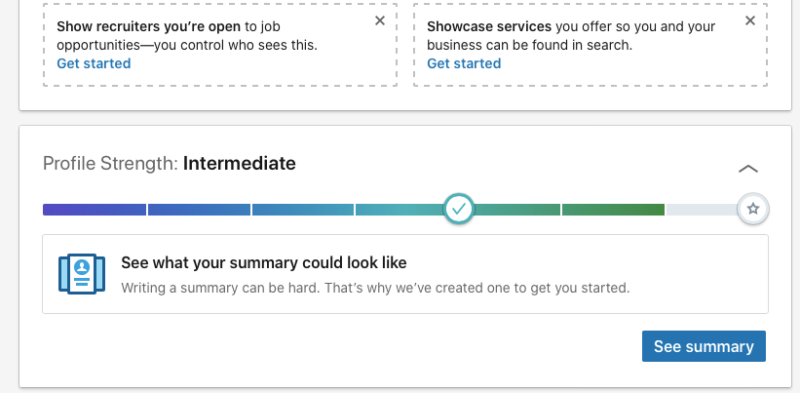
They even provide tips and samples for how to complete different sections of your profile, based on the most recent best practices. So definitely take advantage of the advice they offer!
Profile Views and Engagement
LinkedIn profiles with more profile views and engagement overall often appear higher in search. This reflects their popularity and authority on the platform.
Connections and Network
Who you're connected to impacts your search visibility, especially among 2nd and 3rd degree connections searching for people similar to you.
Now that we've covered the basics of how LinkedIn's search algorithm works, let's dig into specific optimization tactics to improve your rankings.
What Types of Keywords Should I Use?
Before you start doing any research, it’s important to think about which types of LinkedIn profile optimization keywords you’ll be looking for. This will very much depend on what your goals are for using LinkedIn.
For instance:
Are you trying to find employment? Hoping local companies will find you because of your location and skills?
Are you hoping your profile shows up #1 in Google for your name?
Are you looking for new clients, and want them to find your profile based on the services you offer?
As you can see, the keywords you’ll target will vary depending on your goals.
However, here’s a general list of keyword categories you’ll probably want to choose from:
- Job titles
- Cities or regions
- Your name
- Name of your degree or field of study
- Industry-specific skills
- Services you offer
- Products you sell
- General industry keywords
Using this list will give you a good place to start as you begin your research. But, now the question is…
How do I Find Keywords to Use in My Profile?
Finding and using the right keywords in your profile will give you the best chance of getting found – both in LinkedIn Search and in Google.
[click_to_tweet tweet=”Finding and using the right keywords in your LinkedIn profile will give you the best chance of getting found – both in LinkedIn Search and in Google.” quote=”Finding and using the right keywords in your profile will give you the best chance of getting found – both in LinkedIn Search and in Google.” theme=”style6″]While LinkedIn Search may be highly specific to the person doing the search, Google Search is less-so; and using popular and targeted keywords will be your best friend!
There are four main ways you can find keywords to use in your profile. I’ll cover each of these in detail below.
4 Steps to Optimize Your LinkedIn Profile for Maximum SEO
The #1 thing to know about LinkedIn Search is that the results are specific to the person doing the search.
[click_to_tweet tweet=”The #1 thing to know about LinkedIn Search is that the results are specific to the person doing the search.” quote=”The #1 thing to know about LinkedIn Search is that the results are specific to the person doing the search.” theme=”style6″]For instance, one person may search for you and find you on page 7, while another person may find you on page 1 of the results.
Where you show up depends on a variety of factors, including the searcher’s profile, location, and search history.
That said, there are definitely ways you can boost your chances of being found!
Optimizing your LinkedIn profile for greater visibility takes effort, but following this step-by-step guide will help:
1. Research the Right Keywords
As with any SEO strategy, thorough keyword research is the critical starting point.
The keywords and phrases you choose need to be ones professionals would realistically search for when looking for someone with your background or services.
Here are some smart ways to research relevant LinkedIn profile keywords:
1. Leverage LinkedIn's search bar
When people on LinkedIn want to find you or someone with your skills or job title, they’ll start by entering specific words or phrases into the LinkedIn search bar.
Once they finish typing and hit the magnifying glass icon, they’ll see a number of search results they can choose from.
LinkedIn then allows users to filter these search results into a number of different categories, including people, jobs, content, companies, schools, and groups.
These filters are so helpful! They allow you to really drill down to find exactly what you’re looking for.
As with all search tools (whether it’s Google Search, Facebook Search, Instagram Search, etc.), the results will be dictated by the platform’s search algorithm.
Fortunately, the powers-that-be at LinkedIn have given us some clues as to how these results are ranked.
Why not go straight to the source?
Start typing your keywords into the search bar, and see what pops up. For instance, if I type in “HR”, I immediately notice several people use the title “HRMD” (Human Resource Management and Development). This is a good indication this is a popular keyword in my network, so I’ll want to make sure I use it in my profile.
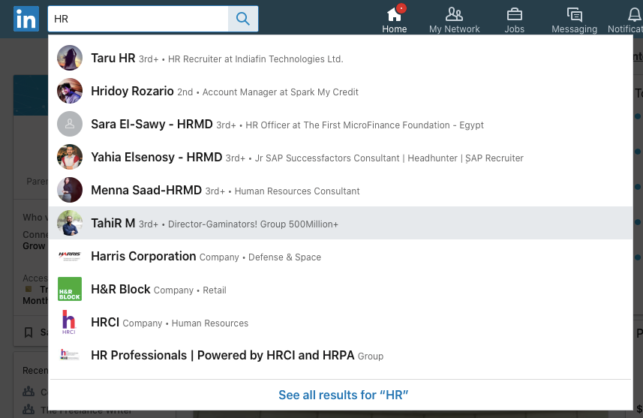
Run a number of different searches and gather as many relevant keywords as you can. You can immediately start using these keywords in your profile (more on this later), or use them as a starting point for further keyword research using other tools.
You’ll also notice that as you search for keywords, LinkedIn is paying close attention. If you clear your search bar, and you’ll notice a new list of suggestions (under “Try searching for”) below your recent search history.
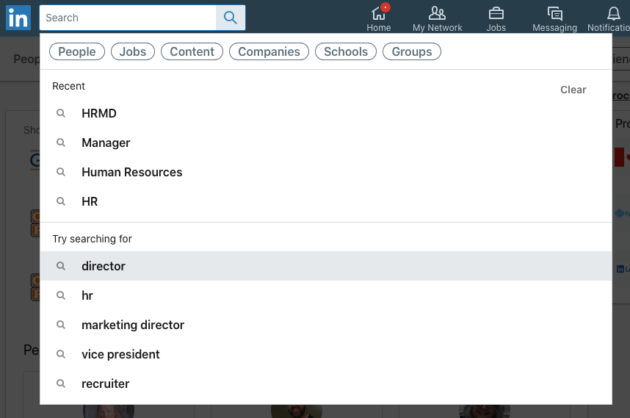
LinkedIn has determined these keywords are related to the ones you’ve already searched for, so feel free to use these for your research as well!
2. Use LinkedIn autocomplete suggestions
As you type keywords into the search bar, pay close attention to the autocomplete suggestions that pop up. These reflect popular searches on LinkedIn.
3. Browse competitor profiles
Finally, I strongly recommend visiting the LinkedIn profiles of other people in your niche to see what keywords they’re using.
Do a search for people with your same job title or role, then filter the results by “People”.
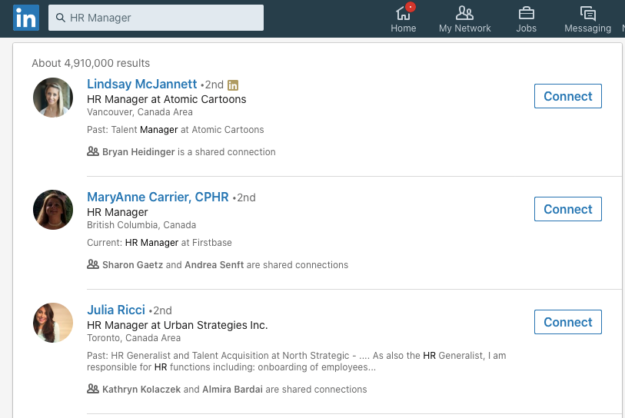
Keep in mind that LinkedIn is showing you results based on your connections, search history, and past actions – so they aren’t “true” search results (i.e., every user will get different results).
You’ll also find that not all profiles will be public; but at the very least, you’ll be able to see which keywords people are using in their headlines. And these can be a great source of ideas and inspiration for other keywords you may want to use and test for yourself.
4. Use keyword research tools
One of my favorite tools for doing keyword research is SEMRush.
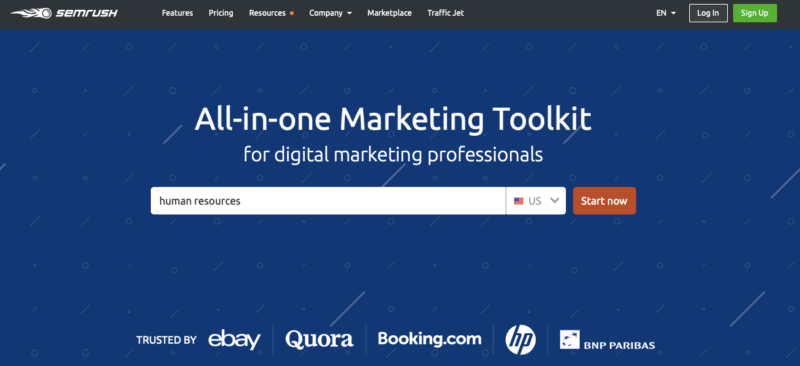
Using their free plan, you can perform up to 10 searches per day, which will get you off to a good start.
Simply enter a keyword, and you’ll get a ton of information about it including:
- How many people search for that keyword in Google
- Variations of that word or phrase
- Related keywords
- How difficult it is to rank for that keyword
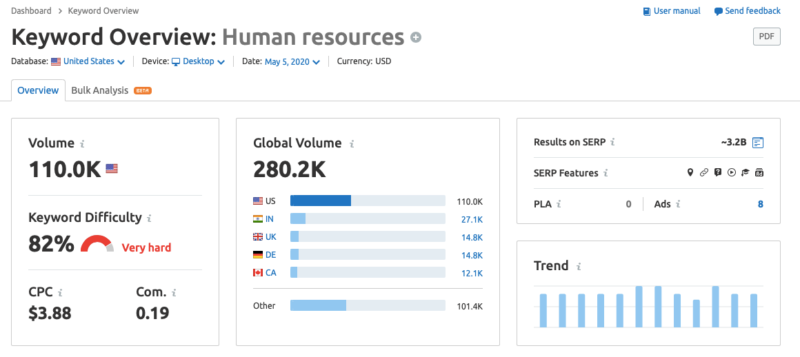
In general, you’ll want to choose keywords that are extremely relevant to what you do, that have a decent search volume, and that have a lower keyword difficulty.
Another great tool you can use for keyword research is the Google Keyword Planner. It will show you approximately how many searches happen each month for your keyword, as well as how much competition there is for that keyword (competition relates to advertising, but it can still give you a decent idea of how hard it will be to get found for that term). It will also suggest related keywords you could use.
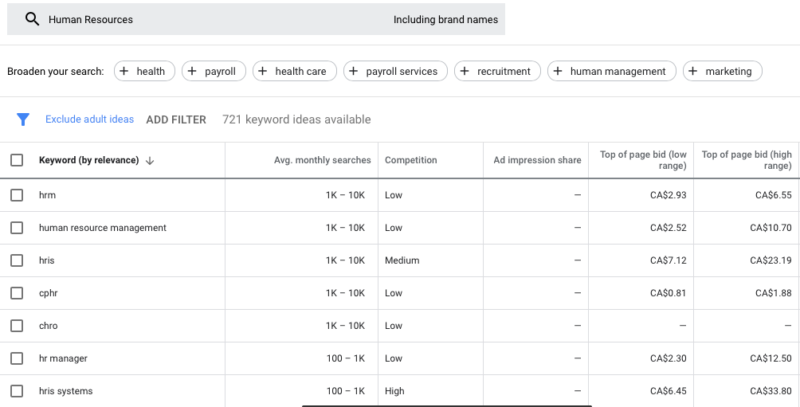
Once you have a list of 10-20 relevant, high-potential keywords, you're ready for the next step.
2. How to Optimize Your LinkedIn Profile for SEO
With your target keywords in hand, it's time to work them into key sections of your profile naturally. Avoid awkwardly cramming in keywords that don't flow well.
Here are the profile sections to focus your optimization efforts on:
Headline – Your headline sits right below your name and is prime real estate for establishing your professional identity and focus with keywords. Keep it clear and concise.
About summary – Share your background, passions, and approach in a scannable, keyword-laced summary. Aim for an informative narrative flow over rigid keyword stuffing.
Experience descriptions – For each role and project, incorporate keywords relevant to your accomplishments and industry. Quantify results when possible.
Skills section – Including relevant skills in your profile is great for SEO, as it gives you another place to use your keywords. According to LinkedIn’s own research, it’s important to make sure you’ve listed a minimum of 5 skills, as users that have at least 5 skills listed are 27X more likely to get found in searches by recruiters.
When you add skills, it also gives other users an opportunity to endorse those skills: and we know that profiles that have more endorsements also rank higher in LinkedIn Search.
So adding skills is just a great move, all around!
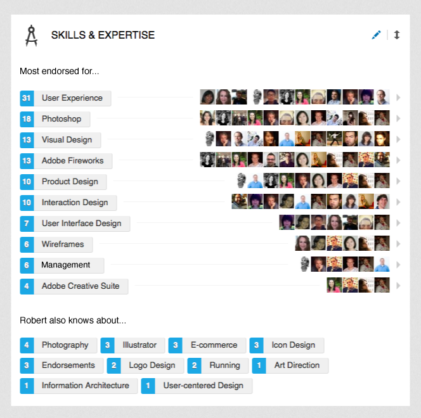
Education – Include your degree and field of study using their proper keyword names.
Profile URL – Did you realize that your LinkedIn page's default URL isn't set in stone? Initially, LinkedIn assigns a URL filled with random numbers, something along the lines of:
www.linkedin.com/in/your-name-2knsdf83
To give your LinkedIn page an SEO boost, you have the option to modify this URL to include a keyword relevant to your field. For instance, if your expertise lies in digital marketing, you could tailor your URL to look like this:
www.linked.com/in/digitalmarketingexpert
Using a descriptor that is specific to your industry or your company name in the URL can also be an effective strategy for being found.
To set your custom URL simply click on the “Edit public profile & URL” link at the top right of your profile, you can change this to whatever you like.
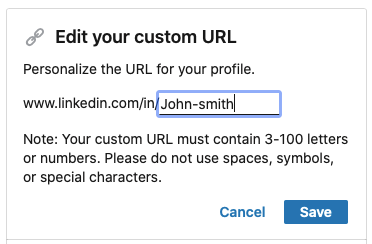
3. Build an Engaged Network
Remember, LinkedIn search results favor profiles with more robust networks and follower bases. Here are some tips to build a thriving LinkedIn network:
- Expand your connections – Grow your LinkedIn network by regularly sending thoughtful connection requests. Prioritize connecting with key players in your industry.
- Join industry-related groups – Become an active member in niche LinkedIn groups related to your profession. Post helpful insights and engage with other members.
- Follow influential profiles – Follow thought leaders in your space to stay on their radar. Like and comment on their posts when possible.
- Encourage engagement – Ask connections to endorse your skills, leave recommendations, and engage with the content you post. High activity signals you're influential.
- Share valuable insights – Post regular status updates with links, images, and insights valuable to your professional network. Encourage shares and discussion.
Nurturing an engaged LinkedIn network boosts the visibility of your profile in their searches, multiplying your reach.
4. Maintain an Active Presence
The final piece of the LinkedIn SEO puzzle is consistency. You need to actively maintain your profile over time.
Here are some best practices for keeping your profile active and optimized:
- Update regularly – Add any new positions, projects, skills, and accomplishments as they happen to stay current.
- Check back on keywords – Revisit your keyword research every 6 months to see if there are any new relevant terms to work in.
- Interact daily – Set aside 10 minutes each weekday to engage with your network by commenting, posting, and sharing content.
- Monitor analytics – Check your LinkedIn analytics to see how well your content is performing and what's getting engagement.
- Join conversations – Look for trending industry discussions on LinkedIn where you can provide your insights and perspective.
Committing to regular maintenance of your profile will keep it lively, fresh, and optimized for ongoing discoverability in LinkedIn search.
Advanced LinkedIn SEO Tactics

Once you have the basics down, here are some more advanced tactics to take your LinkedIn SEO to the next level:
- Request profile recommendations – Ask satisfied colleagues, employers, and clients to leave recommendations highlighting keywords relevant to your expertise.
- Publish long-form articles – Use LinkedIn's publishing platform to share 800+ word articles that showcase your thought leadership.
- Use multimedia – Incorporate relevant graphics, infographics, slides, and videos into your profile and posts to gain traction.
- Leverage hashtags – Include niche hashtags related to your industry, causes, and expertise to tap into wider discussions.
- Start or engage in Groups – Active membership and engagement in professional Groups signals you as an expert.
- Embed LinkedIn profile – Add a LinkedIn follow button to your website, emails, and elsewhere to accumulate more profile views.
Master these advanced tactics, and your LinkedIn SEO visibility will reach new heights.
LinkedIn SEO Tips for Job Seekers
If your primary goal on LinkedIn is networking to find new job opportunities, here are some tailored SEO tips:
- Highlight relevant skills – Feature keywords in your headline and skills section that apply specifically to roles you want.
- Quantify achievements – Use measurable results and data in your experience summaries to showcase your qualifications.
- Emphasize education – Put your degree, certifications, and other credentials on display with keywords.
- Personalize outreach – Reference specifics when requesting to connect with recruiters and hiring managers.
- Set alerts – Get notified when relevant new jobs are posted by setting up search alerts for target keywords.
- Follow companies – Stay in the loop on new opportunities by following your target employers.
With strategic optimization, your LinkedIn profile can become a magnet for exciting new career opportunities.
Common LinkedIn SEO Mistakes to Avoid
There are a few key mistakes that can damage your LinkedIn SEO visibility. Be sure to steer clear of:
- Keyword stuffing – Cramming keywords randomly into sentences feels unnatural and can get your profile flagged.
- Inconsistent branding – Using different variations of your name and company name creates confusion.
- Outdated information – Leaving old positions and accomplishments makes it seem like you have nothing new to offer.
- Too few keywords – Focusing on just 1-2 keywords leads to very limited search visibility. Cast a wider net.
- Ignoring multimedia – All text profiles have a generic feel and tend to blend into the background.
Avoid these missteps, and your thoughtful SEO efforts will be rewarded in LinkedIn's search results.
How to Measure Your LinkedIn SEO Results
Here are two ways to track your progress in optimizing your LinkedIn profile for greater search visibility:
- Monitor search ranking – Run test searches for your target keywords periodically to see if you start ranking higher over time.
- Use LinkedIn analytics – Review metrics like profile views and post impressions to see if engagement is trending up.
Consistently appearing higher in LinkedIn searches for your name, company, and keywords shows your optimization efforts are paying off!
Optimize Your LinkedIn Profile for Success
I hope this comprehensive guide provided you with lots of valuable tips and strategies to optimize your LinkedIn presence for maximum visibility.
The time you invest in thoughtful LinkedIn SEO will directly strengthen your professional reputation and expand your career opportunities.
To recap, the key steps are:
– Researching niche keywords that professionals search for
– Incorporating those keywords naturally into key profile sections
– Building an engaged network of connections
– Maintaining an active presence through regular posting
Final Thoughts
Even if the idea of keyword research and SEO strikes fear in your heart, you can do this!
Optimizing your LinkedIn profile and choosing the right keywords isn’t complicated, and shouldn’t take you a ton of time.
And once you’re done, you can feel confident knowing that the people who are looking for you are far more likely to actually find you!
About Author
Kim Garst
Kim Garst is a renowned marketing strategist and speaker who is trailblazing the use of artificial intelligence in digital marketing. With over 30 years of experience as an online entrepreneur, Kim helps entrepreneurs grow their business and authority online by using AI technology. She is leading the way with proven AI frameworks that help entrepreneurs build authority in their space.
She is keynote speaker and an international best-selling author of Will The Real You Please Stand Up, Show Up, Be Authentic and Prosper in Social Media.
Named by Forbes as a Top 10 Social Media Power Influencer, Kim is well-known for her skill to simplify complex technology and make the use of AI understandable for business growth. Her relatable, actionable advice helps guide new entrepreneurs to harness the power of AI to succeed in digital marketing. Kim is leading the way in combining human and technological skills to create a new model for AI-powered marketing.


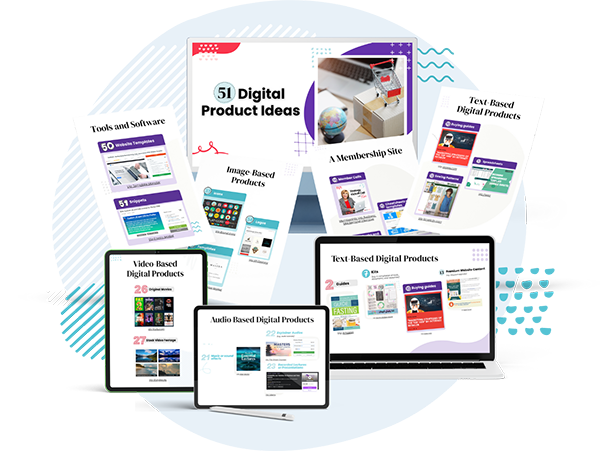
95 thoughts on “How to Choose The Right Keywords For Your LinkedIn Profile”
Hey Kim, amazingly useful article as always 🙂 Love your blog!
Thank you for dropping in!!
Hey Kim, amazingly useful article as always your blog.very good information
Hey kim,By reading your post I have got lots idea to set up my Linkedin profile.
Thanks for amazing post.
This is very usefull post thank for share your post
love it learn lots thank u
This artical very helpful to me. Thank you
Your content is always pleasure to read…I don’t understand how u will collect so much of information.really amazing
your best content Thank you
Linked is one of the toughest social media platform. THanks for your idea for making it easy
I was reading this and i realy found what i was looking for your article is really informative and i’ll be grɑteful if ʏou keep writing in the future.
Hi Kim,
Absolutely Agree, LinkedIn an wonderful platform , it helps us to connect with so many Professional people.
And the methods you shared in the post is absolutely insightful,
Thank you.
I learn a lots, I updated my profile.
Thanks for article.
thanks sir very helpful articles
hi kim thanks for sharing this.
Nice information
I hope everyone will benefit for this information Thankyou
one of best article I ever read on keyword research on linkedin..
Great Article Thanks For Sharing This Article
Hi
This is one of the most informative and educational post Actually, I’m searching this kind of material. Thank you so much for sharing this post.
Hi! i really enjoy the blog and it is one of the best blog i ever read on keywords research on LinkedIn.
Hi. Thanks for this information i really like this
WAOOW.. This website is seriously very incredible and informative. I seriously prefer this website guyzz..Outstanding
hi kim i am big fan of yours…such a amazing detailed article..thanks a lot
Most of the people are still not serious about optimizing social media profile.
They should learn from your blog.
Thanks!
very helpful Article, I liked your all articles
I hope everyone will benefit for this information thanks for sharing this.
Hi Kim
I really like this blog and very helpful blog about optimizing social media profile and benefit information everyone who use social media
Thank you for sharing this informetive informetion about linkdin..
Hi i read you article but i just want to know can i used google adwords keyword planner for linkedIn. Please Guide me.
usefull post.well written content
love the post .keep it up .very informative post
amazing information about linkdin.thanks for this post
thanks for the excellent write up on LinkedIn keywords, looking forward for more such information on LinkedIn, regards, KC
Thanks For Share This Information. It Is Very Helpfull.
Thank you for this amazing post. I will follow this steps to increase followers on my profile.
wow nice
how to create a dropdown menu using html and css
https://youtu.be/gEWVWxsL0rY
Hi kim,
Hope you are fine.
Thank you so much for sharing this information.
Alllah Bless you.
I’ve made a linkedin profile and never really looked at it as other than somewhere to keep in touch with professionals I worked with previously. I have been considering using it for other reasons, for example recruitment and this has really helped me identify some areas I need to focus on and learn to use the platform and grow! Thanks for the tips on keywords, extremely valuable.
This is very helpful article! Thank for share your post! I always try to apply your tips at my work!
Thanks for sharing these useful informations. As i am planning to boost my social media marketing, it was really very helpful post. By reading it, I gained lots of valuable resources and informations. Keep up the good work.
Thank you for sharing the wonderful Article how to choose the write keywoard for likedin profile, how to develop linkedin
This an exceptionally useful blog I am feeling cheerful perusing this post. I am glad to discover your blog I was searching for data like this. Great work continues composing like this later on. Much appreciated.
Thanks For this amazing Post I get knowledge about it.
Thank you for this post, I’m going to put this into practice and apply the tips to my LinkedIn profile!
This really helpful for any buiseness and SEO Student
thnaks for share this information
This information very helpful for me because i am SEO student
NICE ARTICLE
Hi Kim Garst
The information you have given in this blog post about the right keywords was very helpful for me thank u so much for sharing and educating
Thank You
Hi
This is one of the most informative and educational post Actually, I’m searching this kind of material. Thank you so much for sharing this post.
Great Article Sir I like your Work Keep writing Sir..
Your Post is So Informational Sir.
Thanks for this Content
wow awesome article.thanks for share
how to create a dropdown menu using html and css
https://youtu.be/gEWVWxsL0rY
An awesome post!
A really helpful article to find the right keyword for linkedin profile. Today first time I have visited this blog and found many informative posts.
Appreciate your efforts.
Thanks.
Very nice post dear.
It is awesome tips, thanks for your great article.
This artical very helpful to me. Thank you and Love your blog.
Great article for everyone. Thank you so much for sharing this one. I loved it.
thanks for sharing this post i have get some knowledge after read this post or article
<
Very helpful article, after reading your article I got enlightenment on finding the right keywords thank you so much for such helpful article.
Hi I like your post
Thanks for sharing this information, it is very useful.
thank you for sharing great article it is really helpful for me.
Hi Namaste from Nepal.
when i read your acticl one by one its really helpful, i enjoyed lot and gest many knowladge thenks for sharing your helpful article with us, Many thanks.
This really helps a lot ! Thanks Kim
Very informative article . Keep writing such nice post
i heard about this blog & get actually whatever i was finding. Nice post love to read this blog
thanks for the excellent write up on LinkedIn keywords, looking forward for more such information on LinkedIn, regards, KC
Very Informative and helped me a lot.
Keyword play a major role. Thanks for sharing this information. This really helps me a lot!! Keep Rocking!!
Very helpfull. Thanks a lots kim
An amazing post! Thanks for sharing this information. It is very helpful for me as well as my friends.
Hi Kim
LinkedIn is very important in social media, Thanks for sharing the information, really usefull for me. Kee up the good work
Thank you
excellent article,i love this article,you are great
Thanks for sharing this useful information. Your Article really helps me a lot. Keep sharing informative posts.
Hi, Thank you for Sharing. Very insightful article.
choosing the right keywords are really help for the growth and increase the visitors promptly to your website. Very good and helpful information posted. Thank you.
This post is very useful. Thank you!
Thank you for the great insight into choosing keywords to use on Linkedin. I struggle with which keywords to attach to my posts. They never seem to deliver like I would hope. I will use the research method next time. Thanks!
Thanks Kim, for guiding and sharing this information.
Thanks for sharing this wonderful content.
keep it up.
This is really a goog article, thanks for sharing this article.
Thanks for sharing this information.
Thanks for sharing this useful information. Your Article really helps me.
Thanks for sharing the information, really usefull for me. Kee up the good work.
Thank you for sharing great article.
Best Article ever for Choose The Right Keywords For Your LinkedIn Profile Thank you Sharing your Valueable information. office rent in noida, office spaces in noida, rental office space in noida
very helpful thanks a lot
Very helpful and terrific article. Thanks a lot for sharing great content.
Very helpful article. thanks a lot for sharing this great content on Keyword selection for LinkedIn profile.
Hi Author,
Thank a lot for sharing this awesome info. Nice Article i am happy to read it and learned a lot. Thanks
Thanks
good experience
i optimise my profile with the help of this article and guess what. now i have 10000 connection on linked. thanks for sharing it with us
THnaks for sharing this informative article with us., it requred so much knowledge to optimize linked in profile and the way you describe everything make me agree that you have so much knowledge of keyword research. Thank you so much
Thanks for sharing this informative article with us. Nice Article i am happy to read it and learned a lot. Thank you again.
You’re welcome! Keep reading!